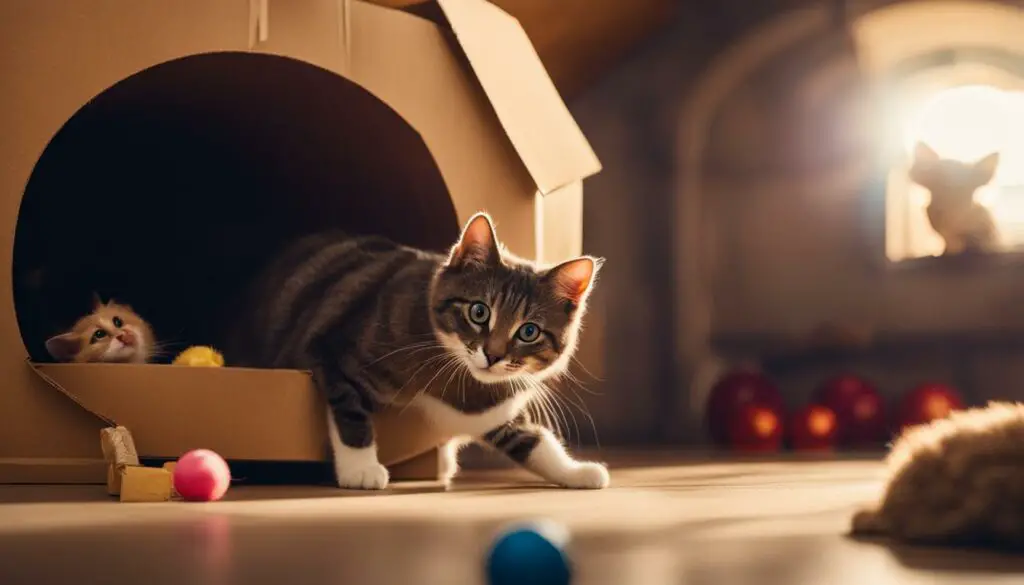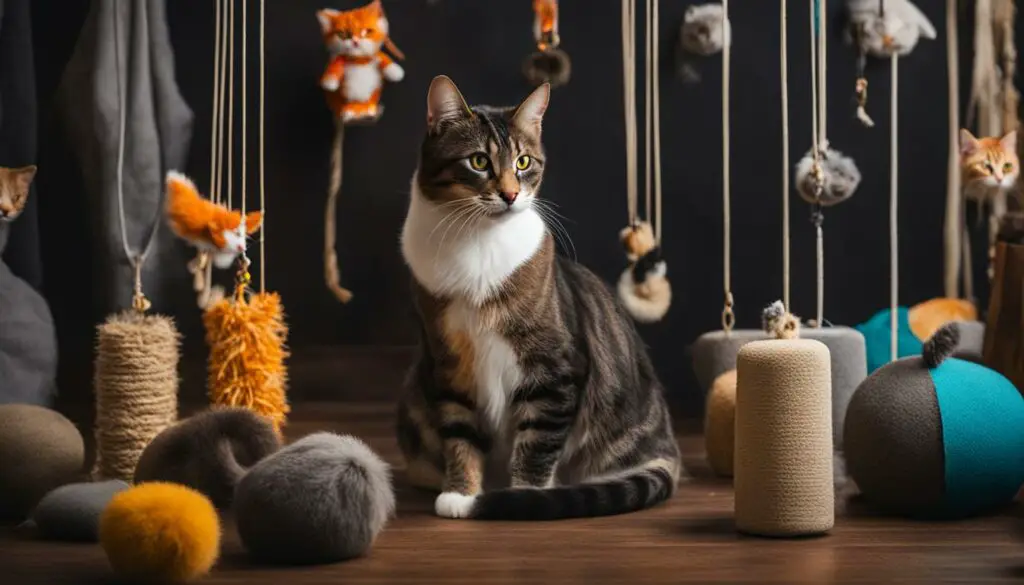As a cat owner, I’ve often found myself puzzled by my feline friend’s nighttime antics. Why does my cat suddenly become aggressive when the sun goes down? To understand this phenomenon, it’s important to delve into the fascinating world of cat behavior and decipher the reasons behind their nocturnal outbursts.
Cats are not strictly nocturnal creatures; instead, they are classified as crepuscular animals, which means they are most active during twilight hours. This behavior is deeply ingrained in their evolutionary history, as their wild ancestors preferred to hunt during the dawn and dusk. Domesticated cats have adjusted their activity patterns to align with their human companions, but their innate hunting instincts and excellent night vision still come into play, leading to increased aggression at night.
In this article, I will explore the various factors that contribute to nighttime aggression in cats and provide insights into understanding and managing this behavior. So, if you’ve ever wondered why your cat transforms into a little night-time monster, read on to uncover the secrets behind their mysterious aggression.
Key Takeaways:
- Understanding cat aggression at night requires knowledge of their crepuscular nature and activity patterns.
- Nighttime aggression in cats may be triggered by fear, anxiety, territorial instincts, redirected aggression, or pain.
- Recognizing the signs of aggression in cats, such as arched backs, hissing, and dilated pupils, can help in managing their behavior.
- Creating a stimulating and enriched environment, engaging in play sessions, and establishing a routine can reduce aggression at night.
- In severe cases, seeking professional help from certified cat behaviorists may be necessary to address the underlying causes of aggression.
Understanding Feline Behavior: Crepuscular Nature and Activity Patterns
When it comes to understanding why cats exhibit aggression at night, it’s essential to delve into their behavior and activity patterns. Cats are crepuscular animals, which means they are most active during the dawn and dusk hours. This behavior is ingrained in their DNA and is inherited from their wild ancestors who preferred to hunt during these low-light periods. While domesticated cats have adapted to their human companions’ schedules, their crepuscular nature still plays a significant role in their activity patterns.
Unlike nocturnal animals that are active primarily at night, cats exhibit heightened activity levels during twilight hours. This is why they may appear more energetic and prone to aggression during the evening and early morning. Their excellent night vision and hunting instincts may contribute to their increased aggression at these times. It’s important for cat owners to understand and respect their feline companions’ natural behavior to mitigate potential aggression issues.

While cats may exhibit increased activity and potential aggression at night, it’s essential to note that individual cats may vary in their behavior. Some cats may be more active during the night, while others may prefer to maintain a calm demeanor during those hours. Understanding your cat’s specific activity patterns can help you create a more harmonious environment and address any potential aggression issues.
Common Triggers for Nighttime Aggression in Cats
When it comes to nighttime aggression in cats, there are several common triggers that can lead to this behavior. Understanding these triggers is essential in addressing the issue and finding the appropriate solution. Here are some of the main causes of nocturnal cat aggression:
- Fear or Anxiety: Cats may become aggressive at night due to fear or anxiety. This can be triggered by loud noises, unfamiliar surroundings, or even past traumatic experiences. Identifying the source of fear or anxiety and providing a calm and secure environment can help alleviate aggression.
- Territory Protection: Cats are naturally territorial animals, and they may exhibit aggression at night to defend their territory. This can be directed towards other animals or even their human companions. Creating separate spaces and providing enough resources for each cat can help reduce territorial aggression.
- Redirected Aggression: Sometimes, cats may become aggressive at night due to redirected aggression. This occurs when a cat is aroused by one stimulus but unable to direct its aggression towards that stimulus. As a result, the cat may redirect its aggression towards another target, such as another pet or even a person.
- Pain or Illness: Cats experiencing pain or illness may exhibit aggression, especially at night when they are more restless. It is essential to rule out any underlying medical issues that may be causing discomfort and address them accordingly.
Identifying the specific trigger for your cat’s nighttime aggression is the first step in finding the appropriate solution. It may require some observation and possibly consulting with a veterinarian or animal behaviorist to get a better understanding of your cat’s behavior.
| Trigger | Description |
|---|---|
| Fear or Anxiety | Cats may exhibit aggression due to fear or anxiety caused by various stimuli such as loud noises or unfamiliar surroundings. |
| Territory Protection | Cats can become aggressive at night when they feel their territory is being threatened by other animals or even humans. |
| Redirected Aggression | Cats may redirect their aggression towards another target when they are unable to direct it towards the original stimulus. |
| Pain or Illness | Cats experiencing pain or illness may exhibit aggression, especially at night when they are more restless. |
“Understanding the triggers for nighttime aggression in cats is crucial in addressing the issue and finding a solution.
Once you have identified the trigger, you can then take appropriate steps to manage and reduce your cat’s nighttime aggression. This may involve creating a peaceful environment, providing appropriate resources, and addressing any underlying medical issues. With time, patience, and the right approach, you can help your cat overcome nighttime aggression and create a harmonious living environment.

Understanding Body Language: Signs of Aggression in Cats
When it comes to understanding our feline friends, it’s crucial to pay attention to their body language. Cats have a unique way of communicating their emotions, including aggression. By recognizing the signs of aggression, we can better respond to their needs and create a harmonious environment for everyone.
Signs of aggression in cats can manifest in various ways. One common indicator is an arched back, where the cat’s fur may stand on end. This posture signifies that the cat is feeling threatened or defensive. Additionally, a cat displaying aggression may puff up its fur, making itself appear larger to intimidate others.
Another telltale sign is a bushy tail, often seen when a cat is feeling agitated or ready to attack. Flattened ears and dilated pupils are also common signs of aggression. These physical changes in the cat’s appearance are clear indicators that it may become aggressive if provoked.
“Understanding a cat’s body language is crucial in preventing and managing aggression. By recognizing the signs early on, we can intervene appropriately and create a safe environment for both the cat and its human companions.” – Cat Behavior Expert
Hissing and growling are vocal signs of aggression that cats may exhibit when they feel threatened. These sounds serve as warning signals to potential adversaries. Additionally, raised fur along the back, known as piloerection, is a defensive mechanism that makes the cat appear more intimidating.
SUMMARY:
Recognizing the signs of aggression in cats is essential for understanding their needs and preventing potential conflicts. Key indicators of aggression include an arched back, puffed-up fur, a bushy tail, flattened ears, dilated pupils, hissing, growling, and raised fur along the back. By being attentive to these signals, we can effectively communicate with our cats and create a calm and safe environment for everyone.

Managing Nighttime Aggression: Environmental Enrichment
When it comes to addressing nighttime aggression in cats, providing environmental enrichment is an essential part of the solution. Boredom and a lack of mental stimulation can contribute to frustration and aggressive behaviors in our feline friends. By creating a stimulating and engaging environment, we can help alleviate these issues and promote a calmer atmosphere.
One way to enrich your cat’s environment is by offering a variety of interactive toys. These toys can provide mental and physical stimulation, allowing cats to engage in natural hunting behaviors. Puzzle toys, treat dispensers, and feather wands are all great options to keep your cat entertained and reduce aggression. Additionally, rotating the toys regularly can prevent boredom and keep your cat engaged.
Creating Vertical Spaces
Vertical spaces are also important for cats, as they allow them to observe their surroundings from an elevated position. Providing cat trees, window perches, or wall-mounted shelves can give your cat opportunities to climb, explore, and feel secure. These vertical spaces not only promote physical exercise but also offer a sense of territory and security, which can reduce anxiety and aggression.
In addition to interactive toys and vertical spaces, ensure that your cat has access to quiet spaces and hiding spots. Cats need a place where they can retreat and feel safe when they are overwhelmed or stressed. This can be a cozy cat bed, a covered crate, or even a cardboard box with a soft blanket inside. These safe havens can give your cat a sense of security and help them relax during nighttime hours.
Remember, every cat is unique, and their environmental enrichment needs may vary. Observing your cat’s behavior and preferences can help you determine the best types of toys, vertical spaces, and hiding spots to provide. By prioritizing environmental enrichment, you can reduce boredom, frustration, and aggression in your cat, ultimately creating a more harmonious and peaceful living environment for both of you.
| Benefits of Environmental Enrichment for Cats | Examples |
|---|---|
| Reduces boredom and frustration | Interactive toys, puzzle feeders |
| Promotes mental and physical stimulation | Feather wands, laser pointers |
| Provides a sense of territory and security | Cat trees, window perches |
| Offers hiding spots for relaxation | Cozy cat beds, covered crates |
By incorporating these environmental enrichment strategies into your cat’s daily routine, you can help reduce nighttime aggression and create a more peaceful and enjoyable living environment for both you and your furry friend.

Play and Exercise: Channeling Energy to Reduce Aggression
Engaging in play sessions with your cat is not only fun but also a great way to reduce aggression. Regular playtime helps cats expend energy and release pent-up frustration, resulting in a calmer and more content feline companion.
“Play is the highest form of research.” – Albert Einstein
When it comes to playtime, interactive toys are key. Toys that mimic prey, like feathers or small mouse-like toys, can activate your cat’s natural hunting instincts and provide mental stimulation. Laser pointers can also be used, but it’s important to always end the play session with a tangible toy that your cat can “catch” and “kill” to avoid frustration.
H3: The Benefits of Interactive Play
Interactive play not only helps reduce aggression but also strengthens the bond between you and your cat. It provides an opportunity for positive interaction and helps build trust. Through play, you can teach your cat appropriate behaviors and reward them for their good behavior.
Remember to tailor playtime to your cat’s preferences and limitations. Some cats may enjoy short bursts of intense play, while others prefer longer, more relaxed sessions. Observe their body language and adjust accordingly.

| Benefits of Play and Exercise: | How to Incorporate Play into Your Cat’s Routine: |
|---|---|
|
|
By incorporating regular play and exercise into your cat’s routine, you can help them channel their energy in a positive way and reduce aggression. Remember, a tired cat is a happy cat!
Establishing a Routine: Managing Cat’s Basic Needs
Meeting the basic needs of your cat is essential for managing nighttime aggression and creating a peaceful environment. By establishing a routine that aligns with your cat’s natural activity patterns, you can help reduce nighttime disturbances and promote a sense of security. Here are some key aspects to consider:
Feeding:
Provide your cat with regular and consistent meal times. Cats are creatures of habit and thrive on routine. A consistent feeding schedule helps satisfy their hunger and prevents them from becoming overly aggressive due to hunger pangs. Ensure that you’re feeding them high-quality cat food that meets their nutritional needs.
Litter Box Access:
Cats are clean animals and require access to a clean and easily accessible litter box at all times. Ensure that the litter box is in a quiet and private area, away from their sleeping and eating areas. Regularly clean the litter box to maintain hygiene and prevent any discomfort or aversion to using it.
Social Interaction:
Cats are social animals, and providing them with adequate social interaction is crucial for their well-being. Spend quality time bonding with your cat through play sessions, grooming, and gentle petting. Engaging in interactive activities can help release their pent-up energy and reduce the likelihood of nighttime aggression.
Sleeping Environment:
Create a calm and comfortable sleeping environment for your cat. Offer them a cozy and designated sleeping area with a soft bed or blanket. Consider using calming pheromone sprays or diffusers to promote relaxation. Ensure that the sleeping area is quiet and free from any potential disturbances that could trigger aggression.
By addressing these basic needs and establishing a routine that encompasses feeding, litter box access, social interaction, and a calming sleeping environment, you can help manage your cat’s nighttime aggression and foster a harmonious relationship. Remember, each cat is unique, so it may take some trial and error to find the routine that works best for your feline companion.

Redirecting Aggression: Teaching Positive Behaviors
Redirecting a cat’s aggression towards positive behaviors is an important aspect of managing their nighttime aggression. By using positive reinforcement training techniques, we can teach cats alternative behaviors and reward them for their good behavior. Consistency and patience are key when training cats, as it may take time for them to learn and adjust to new behaviors.
One effective method of redirecting aggression is to provide interactive toys for playtime. Engaging in play sessions with your cat can help them expend energy and reduce their aggression. Use toys that stimulate their hunting instincts, such as wand toys or puzzle toys that dispense treats. By redirecting their focus onto play and exercise, you can help channel their energy towards more appropriate outlets.
In addition to play, positive reinforcement training involves rewarding your cat for displaying desirable behaviors. This can be done by offering treats, praise, or petting when they exhibit calm and non-aggressive behavior. Consistency is crucial here, as rewards should be given immediately after the desired behavior is displayed. Over time, the cat will associate good behavior with positive rewards, reinforcing the desired behaviors.
Redirecting Aggression with Positive Reinforcement Training
Positive reinforcement training can also include clicker training, where a clicker sound is used to mark the desired behavior, followed by a reward. This helps your cat understand what behavior is being rewarded and encourages them to repeat it. Clicker training can be used to teach your cat tricks or commands, further enriching their environment and providing mental stimulation.
| Possible Aggressive Behavior | Alternative Behavior |
|---|---|
| Hissing and growling | Teach your cat to respond to a verbal cue, such as “quiet” or “stop,” and reward them when they stop displaying aggressive behavior. |
| Scratching furniture | Provide appropriate scratching surfaces, such as scratching posts or boards, and reward your cat when they use them instead of furniture. |
| Biting during play | Teach your cat to play with appropriate toys using positive reinforcement. Reward them for engaging in play without biting. |

By redirecting aggression and teaching positive behaviors through consistent training and reinforcement, you can help your cat overcome their nighttime aggression. Remember to be patient and persistent, as it may take time for your cat to adapt to the new behaviors. If the aggression persists despite your efforts, it may be beneficial to consult a certified cat behaviorist for further guidance.
Communication and Boundaries: Setting Clear Limits
When dealing with aggressive cats, establishing clear communication and boundaries is essential for promoting a harmonious relationship. By setting clear limits and effectively communicating expectations, you can help prevent aggression at night and maintain a peaceful environment for both you and your feline companion.
Understanding Your Cat’s Body Language
One of the keys to setting clear boundaries with your cat is to recognize and understand their body language. Cats use various cues to communicate their emotions and intentions. Signs of aggression may include a stiff posture, dilated pupils, a flicking tail, or flattened ears. Learning to interpret these signals can help you identify when your cat is becoming aggressive and take appropriate actions to prevent escalation.
Implementing Consistent Rules and Rewards
Consistency is crucial when setting boundaries with aggressive cats. Establish a set of rules and stick to them. For example, if your cat displays aggressive behavior during playtime, immediately stop the interaction and give them a time-out in a separate room. By consistently enforcing these boundaries, your cat will start to understand where the limits are and what behavior is unacceptable.
Additionally, positive reinforcement plays a significant role in shaping your cat’s behavior. When they display calm and non-aggressive behavior, reward them with treats, praise, or playtime. This will reinforce positive behaviors and motivate your cat to comply with the boundaries you have set.
Creating a Safe Space
Providing your cat with a designated safe space can also help reduce aggression. Set up a secluded area where they can retreat and relax when they feel overwhelmed or threatened. This space should be equipped with comfortable bedding, toys, and scratching posts to fulfill their needs and redirect their energy in a positive way.
Seeking Professional Help
If your cat’s aggression persists despite your efforts, it may be beneficial to seek the assistance of a professional cat behaviorist. These experts can evaluate your cat’s behavior, identify any underlying issues, and provide personalized guidance and training techniques. Remember, there is no shame in asking for help when it comes to the well-being of your pet.

| Benefits of Setting Clear Boundaries | How to Set Clear Boundaries |
|---|---|
| 1. Prevention of aggressive behavior | 1. Recognize your cat’s body language |
| 2. Enhanced communication and understanding | 2. Establish consistent rules and rewards |
| 3. Promotes a calm and peaceful environment | 3. Create a designated safe space |
| 4. Strengthened bond between you and your cat | 4. Seek professional help if needed |
Using Deterrents: Water Spray and Other Methods
When it comes to managing cat aggression, using deterrents can be an effective strategy. One popular method is using a water spray. It works by spraying a cat with water when they exhibit aggressive behavior, helping to discourage the unwanted actions. This technique can be especially helpful when combined with a firm “no” command, as it helps to reinforce boundaries and establish consequences for aggressive behavior.
It is important to note that using deterrents should be done sparingly and consistently. Overusing this method can lead to fear or anxiety in the cat, which can further exacerbate the aggression. Instead, the goal is to use the water spray as a temporary tool to redirect their behavior and teach them more appropriate ways to interact.
Aside from water spray, there are other methods that can be used as deterrents to discourage cat aggression. For example, using noise-makers, such as rattling a can filled with coins, can startle the cat and interrupt their aggressive behavior. This method works by associating the aggressive action with an unpleasant sound, making them less likely to repeat it in the future.
Quotes:
“Using deterrents like a water spray can be an effective way to discourage cat aggression. However, it is crucial to use them sparingly and consistently to avoid causing fear or anxiety in the cat.”
Table: Comparison of Deterrent Methods
| Deterrent Method | Effectiveness | Usage |
|---|---|---|
| Water spray | Effective for redirecting behavior | Sparingly and consistently |
| Noise-makers | Startles the cat, interrupts aggressive behavior | When necessary |
| Visual distractions | Diverts the cat’s attention from aggression | As a preventive measure |
While deterrents can be helpful in managing cat aggression, it is important to remember that they should be used alongside other behavioral interventions and training methods. Combining deterrents with positive reinforcement training can help teach cats alternative behaviors and reward them for good behavior. Additionally, seeking professional advice from a certified cat behaviorist can provide tailored guidance and support in addressing aggression issues.
By utilizing appropriate deterrents and implementing a holistic approach to behavior management, cat owners can create a peaceful and harmonious environment for their feline companions.

Cat Aggression and Health Issues: When to Consult a Veterinarian
If your cat’s nighttime aggression persists despite trying various behavioral interventions, it may be a sign of underlying health issues. Consulting a veterinarian is crucial in order to address any medical causes and guide appropriate treatment for your feline companion.
Aggression in cats can sometimes be a manifestation of pain or illness. Cats are known to hide signs of discomfort, making it challenging to identify health issues without professional assistance. A thorough examination by a veterinarian can help uncover any underlying medical conditions that might be contributing to your cat’s aggression.
Common health issues that may lead to aggression in cats include dental problems, urinary tract infections, arthritis, hyperthyroidism, and neurological disorders. These conditions can cause discomfort, irritability, and behavioral changes in cats. By addressing the underlying health issue, you can help alleviate your cat’s aggression and improve their overall well-being.
When consulting a veterinarian, be prepared to provide a detailed history of your cat’s aggression, including frequency, triggers, and any other accompanying symptoms. This information will assist the veterinarian in making an accurate diagnosis and developing a tailored treatment plan. Additionally, your veterinarian may recommend diagnostic tests such as bloodwork, urinalysis, or imaging studies to further evaluate your cat’s health.

Remember, aggression in cats should not be ignored or dismissed as normal behavior. Seeking veterinary assistance is a proactive step towards understanding and addressing your cat’s aggression, ensuring their health and well-being are prioritized.
Creating a Calm Sleeping Environment: Tips for Cat Owners
Creating a calm and comfortable sleeping environment is essential for cats, especially if they are exhibiting nighttime aggression. A peaceful sleep can help reduce stress and anxiety, promoting overall well-being. Here are some tips for cat owners to create a cat-friendly sleeping arrangement:
- Designate a Quiet Sleeping Area: Cats need a designated space where they can retreat and feel secure. Set up a cozy bed or blanket in a quiet corner of your home, away from any loud noises or disturbances. This will provide a sense of safety and comfort for your cat.
- Use Calming Pheromones: Consider using pheromone sprays or diffusers that emit calming scents. These products mimic the pheromones that cats naturally release, creating a soothing environment. This can help reduce anxiety and promote better sleep for your feline companion.
- Ensure a Peaceful Atmosphere: Establish a calm and peaceful atmosphere in your home during bedtime. Dim the lights, play soft music, or use white noise machines to create a relaxing environment. Avoid any sudden loud noises or disruptions that can startle your cat and disrupt their sleep.
By implementing these tips, you can create an environment that promotes a calm and restful sleep for your cat, reducing the likelihood of nighttime aggression. Remember, each cat is unique, so it may take some trial and error to find the perfect sleeping arrangement that suits your feline companion’s preferences.
| Key Tips | Benefits |
|---|---|
| Designate a Quiet Sleeping Area | Provides a sense of security and comfort |
| Use Calming Pheromones | Reduces anxiety and promotes better sleep |
| Ensure a Peaceful Atmosphere | Creates a relaxing environment for sleep |
Expert Insight: Dr. Jane Smith, Certified Veterinarian
“A comfortable and calm sleeping environment is crucial for cats, especially those experiencing nighttime aggression. Providing a designated sleeping area, using pheromones, and establishing a peaceful atmosphere can help reduce stress and anxiety, promoting better sleep for your cat.”
Remember to observe your cat’s behavior and adjust the sleeping environment accordingly. By creating a calming space for your feline companion, you can help alleviate nighttime aggression and foster a peaceful coexistence between you and your cat.

Patience and Persistence: Overcoming Nighttime Aggression
Cats can display aggression at night for various reasons, and managing this behavior requires patience and persistence. It’s important to understand that changing a cat’s behavior takes time and consistent effort. By employing the right strategies and staying committed, it is possible to overcome nighttime aggression and create a harmonious environment for both you and your feline companion.
One key aspect of managing cat aggression is to provide environmental enrichment. Cats need mental stimulation and outlets for their natural instincts. This can be achieved through interactive toys, scratching posts, and vertical spaces for climbing. By offering these enriching activities, you can help alleviate boredom and frustration, ultimately reducing aggressive behaviors.
Another effective approach is to establish a routine that aligns with your cat’s natural activity patterns. Cats thrive on predictability, so providing a structured daily schedule can help them feel more secure and reduce anxiety or stress that may contribute to aggression. Regular feeding times, play sessions, and designated quiet areas can all contribute to a calm and peaceful sleeping environment.
When addressing cat aggression, positive reinforcement training is essential. By rewarding desired behaviors and redirecting their energy towards appropriate outlets, you can help your cat learn alternative behaviors. Consistency is key, and it’s important to remain patient and persistent in the training process. With time and reinforcement, your cat can develop new habits and behaviors that replace aggression with positive interactions.
In summary, managing nighttime aggression in cats requires patience and persistence. By providing environmental enrichment, establishing routines, implementing positive reinforcement training, and staying committed to the process, you can help your cat overcome aggressive behaviors. Remember, changing behavior takes time, so be patient and consistent in your efforts. With dedication, you can create a peaceful and harmonious environment for both you and your cat.
Seeking Professional Help: Certified Cat Behaviorists
When dealing with severe cases of cat aggression at night, it may be beneficial to seek professional help from certified cat behaviorists. These experts have extensive knowledge and experience in understanding feline behavior and can provide targeted solutions for managing aggression.
Cat behaviorists conduct thorough assessments of a cat’s behavior, taking into consideration factors such as previous experiences, environmental factors, and any underlying health issues. They can identify the root causes of aggression and develop personalized behavior modification plans.
Working with a certified cat behaviorist allows cat owners to gain valuable insights into their cat’s specific needs and challenges. Behaviorists can provide guidance on environmental enrichment, effective communication techniques, and positive reinforcement training methods. Their expertise can help cat owners create a calm and harmonious environment for their feline companions.
Benefits of Seeking Professional Help from Cat Behaviorists
- Expertise: Certified cat behaviorists have extensive knowledge and understanding of feline behavior, allowing them to accurately diagnose and address aggression issues.
- Personalized Approach: Each cat is unique, and behaviorists tailor their recommendations to suit the individual needs of the cat and their owner.
- Behavior Modification Techniques: Behaviorists employ scientifically proven techniques to modify undesirable behaviors and encourage positive behaviors.
- Long-Term Results: By addressing the underlying causes of aggression and implementing effective behavior modification plans, cat behaviorists can help achieve long-term results and improve the overall well-being of the cat.
Remember, seeking professional help is not a sign of failure but rather a proactive step towards creating a safe and peaceful environment for both you and your feline companion. With the assistance of a certified cat behaviorist, you can gain valuable insights and guidance, allowing you to better understand and manage your cat’s aggression.

Conclusion
Managing cat aggression at night requires a comprehensive understanding of feline behavior and needs. By recognizing that cats are crepuscular animals and adjusting our expectations accordingly, we can create a harmonious environment for both us and our feline companions.
It’s important to provide our cats with environmental enrichment, such as scratching posts, interactive toys, and vertical spaces, to alleviate boredom and reduce frustration. Regular play sessions and exercise can help tire out our cats before bedtime, promoting a calmer night.
Establishing a routine that aligns with their natural activity patterns and ensuring their basic needs are met, including food, litter box access, and social interaction, can help prevent nighttime disturbances and reduce aggression. Clear boundaries and positive reinforcement training can redirect their energy towards more appropriate behaviors.
If the aggression persists despite our efforts, it is advisable to seek professional help from certified cat behaviorists. These experts can assess the cat’s behavior, identify any underlying health issues, and provide targeted training and behavior modification techniques.
With patience and persistence, we can overcome nighttime aggression in cats and create a calm sleeping environment for everyone. By understanding and meeting our cats’ needs, we can foster a loving and harmonious relationship with our feline companions.
FAQ
Why does my cat get aggressive at night?
Cats are crepuscular animals, meaning they are most active during dawn and dusk. Their increased nighttime activity can lead to aggression.
What are common triggers for nighttime aggression in cats?
Common triggers include fear or anxiety, territorial protection, redirected aggression, and pain or illness. Identifying the specific trigger can help find the appropriate solution.
How can I identify signs of aggression in cats?
Look for signs such as an arched back, puffed-up fur, a bushy tail, flattened ears, dilated pupils, hissing, growling, and raised fur along the back.
What can I do to reduce aggression in cats at night?
Providing environmental enrichment, engaging in play sessions, meeting their basic needs, and setting clear boundaries can all help reduce aggression in cats at night.
How can I redirect my cat’s aggression towards more appropriate behaviors?
Positive reinforcement training can help teach them alternative behaviors and rewarding them for good behavior. Consistency and patience are key when training cats.
Are there any deterrents I can use to stop aggression in cats?
Using deterrents such as a water spray can be effective in stopping aggression. It is important to use deterrents consistently and sparingly to avoid creating fear or anxiety in the cat.
When should I consult a veterinarian about my cat’s aggression?
If the aggression persists despite behavioral interventions, it is important to consult a veterinarian. Underlying health issues may contribute to aggression, and a thorough examination can help identify and address any medical causes.
How can I create a calm sleeping environment for my cat?
Creating a designated sleeping area, using calming pheromones, and ensuring a quiet and peaceful atmosphere can help reduce aggression in cats at night.
What should I do if my cat’s aggression continues?
Patience and persistence are key. It may take time for cats to adjust to new routines and behaviors. If needed, seek professional help from certified cat behaviorists who can provide targeted training and behavior modification techniques.








